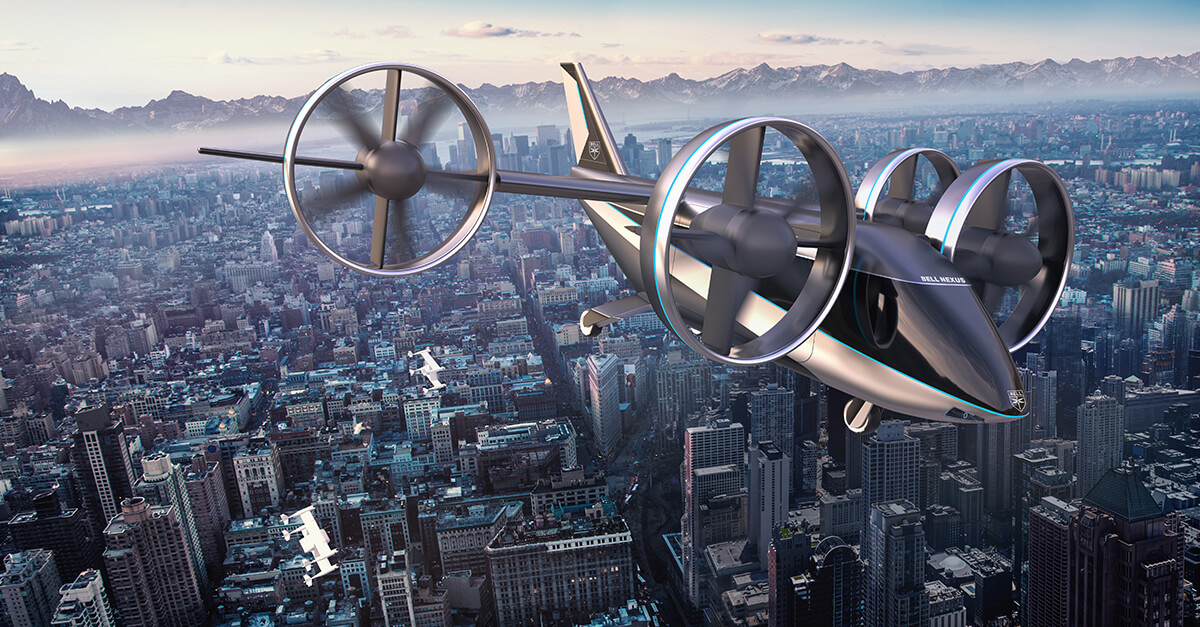
Jan. 9, 2020
Once known exclusively for spotlighting the latest offerings in home entertainment systems and personal electronic devices, the massive annual Consumer Electronics Show (CES) now serves as a major event for the expanding field of electrically powered vertical takeoff and landing (eVTOL) aircraft as well. CES 2020, which took place Jan. 7-10 in Las Vegas, NV, was no exception.
After unveiling its six-rotor Nexus eVTOL urban air mobility (UAM) vehicle at last year’s show, Bell followed up at CES 2020 with AerOS, a digital fleet management mobility platform designed to assist eVTOL operators and cities with the complicated task of integrating UAM into the “vertical landscape” over metropolitan areas.
Bell also unveiled its second UAM concept, dubbed the 4EX. The vehicle utilizes four rotatable ducted fans to carry 4-5 passengers up to 60 miles, cruising at approximately 150 mph. Whereas the larger Nexus – now called the 6HX by Bell – was designed solely for hybrid-electric propulsion, the 4EX allows for either hybrid-electric or all-electric power.
The company highlighted these products and its vision for mobility-as-a-service in a massive “Bell Nexus City” display at the show, featuring scale models of the 4EX and the autonomous pod transport cargo delivery vehicle operating over a miniature metroplex, all managed by the AerOS platform.
South Korean automaker Hyundai also announced its first UAM concept aircraft at CES 2020. The fully electric S-A1 is designed to carry a pilot and four passengers across distances up to 60 miles at speeds up to 180 mph. The S-A1 is just one part of what Hyundai dubbed its “smart mobility solution” that also includes the Hub, linking the S-A1 and other UAM aircraft to Hyundai’s Purpose-Built Vehicle, an autonomous ground transporter offering customized onboard dining, retail or medical service options.
Hyundai also announced its new partnership in the Uber Elevate initiative at CES 2020. “Hyundai is our first vehicle partner with experience of manufacturing passenger cars on a global scale,” said Uber Elevate’s Eric Allison. “Combining Hyundai’s manufacturing muscle with Uber’s technology platform represents a giant leap forward for launching a vibrant air taxi network in the coming years.”

While Bell and Hyundai were the highest profile UAM-related reveals at the show, several other new products and services also were announced.
For example, Elroy Air announced a partnership with EmbraerX to develop the autonomous Chaparral hybrid-electric cargo-carrying aircraft, designed to transport payloads up to 300 pounds over distances of 300 miles, while Doosan Mobility Innovation unveiled its DP30 hydrogen fuel cell powerpack for large UAS, offering more than two hours of flight time and charging in less than 10 minutes.
In yet another sign of aviation’s expanding influence at CES, Delta Air Lines CEO Ed Bastian delivered the event’s keynote address in which he highlighted several new technology initiatives underway at the carrier. Forbes noted the speech represented “a siren call to the entire aviation industry, whose leaders now face a choice: Invest in new tech or get left in the dust.”


 International Business Aviation Council Ltd.
International Business Aviation Council Ltd.